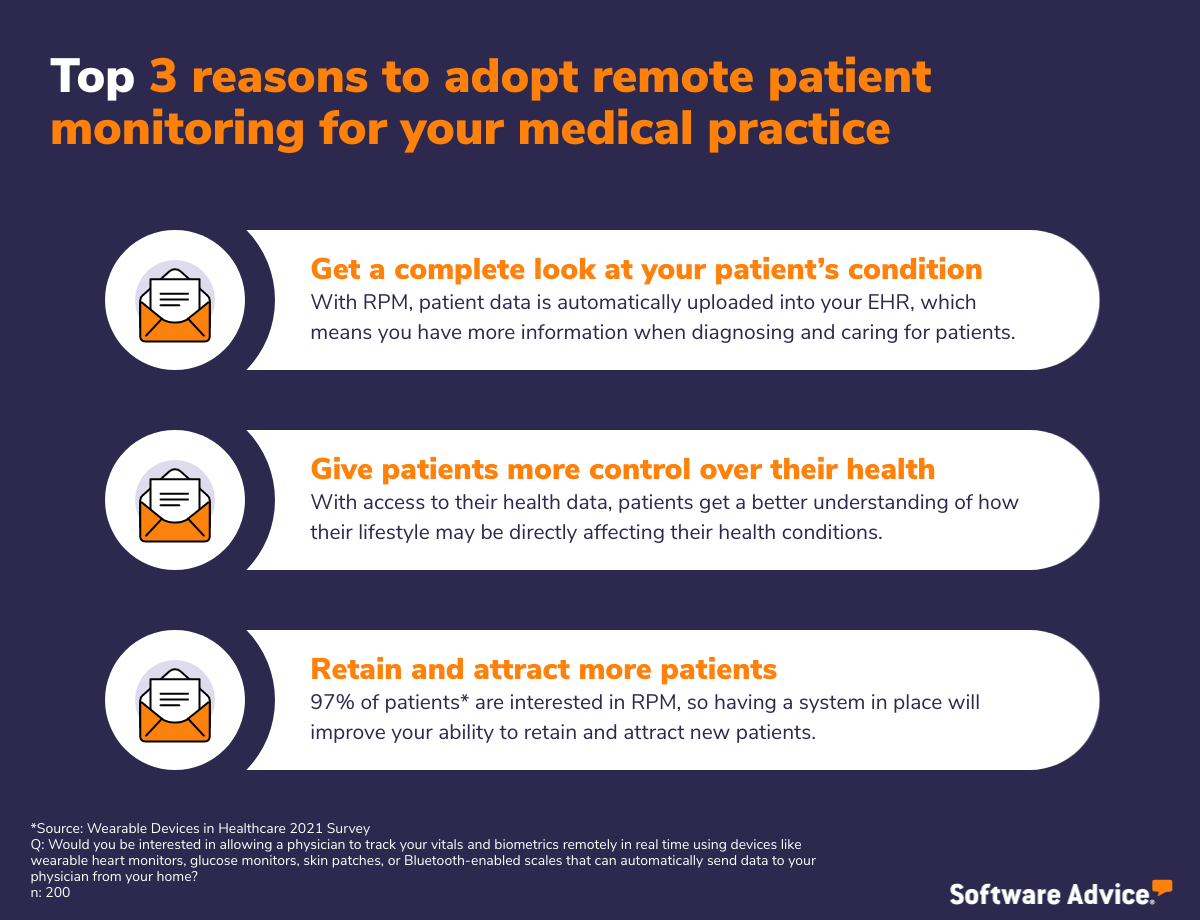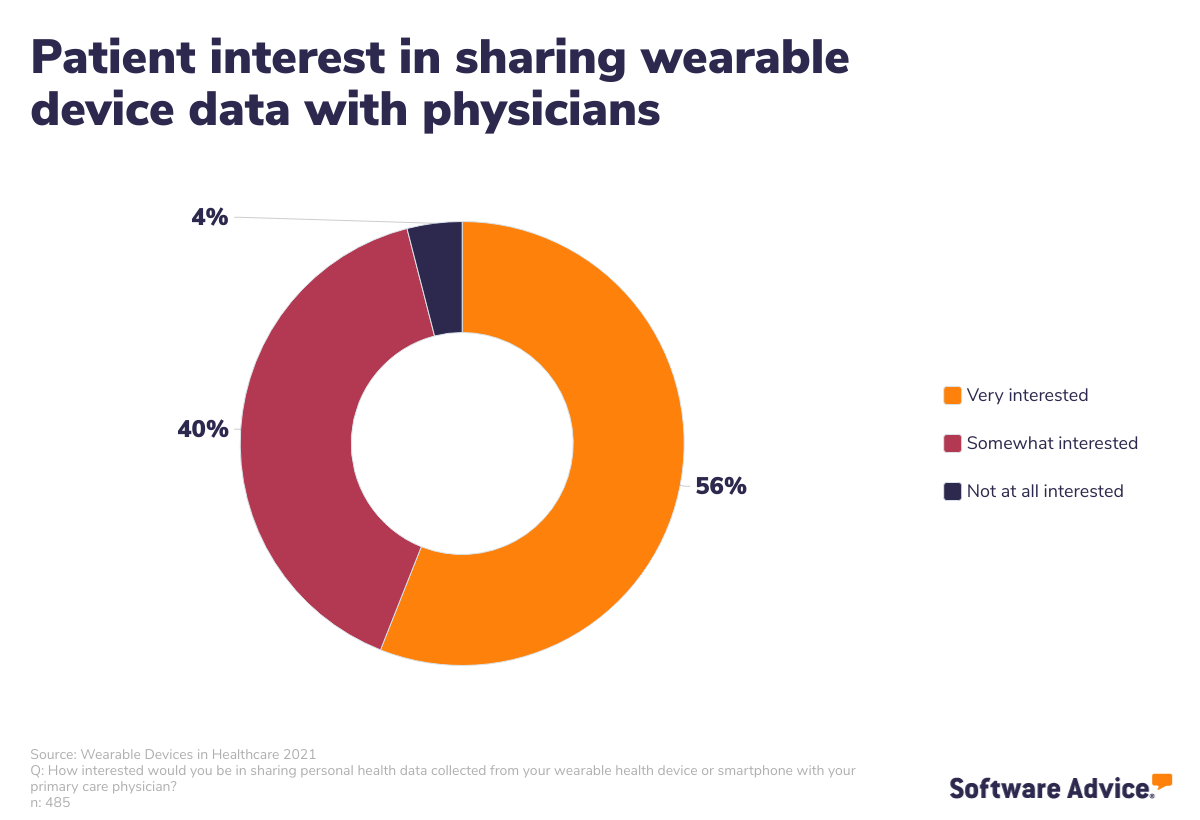A Guide to Remote Patient Monitoring and CMS
Practices risk financial losses if they fail to code care correctly with the Center for Medicaid and Medicare Services (CMS), so if your healthcare organization is thinking about adopting remote patient monitoring services, you need to know what Current Procedural Terminology (CPT) codes to worry about and how they affect your practice.
Remote patient monitoring (RPM) is a healthcare delivery model that uses tech to monitor patients’ health outside of your clinic/practice or in conjunction with a care management service. Essentially, remote patient monitoring uses electronically transmitted patient data to assess and monitor patient vitals remotely.
Adopting a remote patient monitoring program will help your healthcare organization get a more complete look at your patient’s overall condition, give your patients more control over their health, and will make your practice more marketable while helping retain patients.

Your patients with chronic conditions will benefit from the adoption of remote patient monitoring, so it’s important to have a complete understanding of which CPT codes your healthcare organization can use to get reimbursed.
The five primary Medicare RPM codes are CPT codes:
99453, 99454, 99457, 99458, and 99091. Remote patient monitoring codes are considered evaluation and management (E/M) services and can be ordered and billed only by healthcare providers or non-physician practitioners who are eligible to bill Medicare E/M services.
We’ll be going over what each of these codes mean for your practice as well as any considerations to keep in mind.
Here’s what we’ll cover:
CPT codes for reimbursement for remote physiologic monitoring
Remote patient monitoring can be reimbursed with established patients
Guidance for which remote patient monitoring devices qualify for Medicare purposes
CPT codes for setup, education, and supply expenses
CPT codes 99453 and 99454 are practice expense only codes and are valued to cover clinical staff time, supplies, and equipment, including the medical device for remote monitoring.
CPT code 99453 is valued to reflect clinical staff time that includes instructing a patient and/or caregiver about using one or more remote monitoring devices, and CPT code 99454 is valued to include the medical device or devices supplied to the patient and the programming of the medical device for repeated monitoring.
Key considerations
CMS clarifies that the remote patient monitoring devices that are supplied to the patient and used to collect physiological data are considered equipment and are direct practice expense input codes. Still, healthcare providers should always consult with their certified billing and coding professionals for proper Medicare device billing.
To bill for CPT codes 99453 and 99454, data from the remote patient monitoring device must be transmitted for a minimum of 16 days in a 30-day period. It’s important to remember that, even if you spend time educating and distributing remote patient monitoring devices to a patient, if you don’t monitor for at least 16 days in a 30-day period, you cannot report CPT code 99453.
Patient engagement with their remote patient monitoring devices is crucial not just for the success and health of your patient, but for your ability to report and collect.
Average national Medicare payment amount
According to the 2022 Medicare Physician Fee Schedule, the general national payment amount is as follows:
CPT code 99453: $18.48
CPT code 99454: $55.77
Consult with your local payer representative or local Medicare Administrative Contractor to get a better idea about what rates you might more accurately see in your area.
CPT codes for remote physiologic monitoring reimbursement
CPT code 99457 reimburses medical professionals and healthcare organizations for their time spent performing duties related to interpreting remote patient monitoring physiologic data such as medical decision-making to assess patient stability, communication with patients either in person or via telehealth service, and oversight of the management and coordination of service.
Key considerations
CMS mandates a provider services at least 20 minutes per 30-day calendar month in order to report these remote physiologic monitoring services for reimbursement. The work can be done by the provider, other qualified healthcare professionals, or clinical staff under general supervision of the billing provider as defined by your state.
CPT code 99458 is an add-on code to 99457 for each additional 20 minutes of remote physiologic monitoring treatment management service provided in a 30-day calendar month.
Key considerations
CPT code 99458 can’t be billed as a standalone code and must be used in conjunction with CPT code 99457 for any remote physiologic monitoring treatment.
CMS states that the interactive communication required for the 20 minutes may be an audio conversation that occurs in real-time and includes synchronous, two-way interaction that can be enhanced with video or other kinds of data (think telehealth appointments).
They also state that the required interactive communication can include time furnishing care management services for the required interactive communication when it comes to the 20 minutes.
CPT code 99091 is for the collection and interpretation of physiologic data digitally stored and/or transmitted by the patient and/or caregiver to the physician or other qualified healthcare professional. It can also be billed monthly but has more requirements than CPT codes 99457 and 99458.
The requirements are a minimum of 30 minutes of time spent reviewing, interpreting, and reporting data digitally stored or transmitted by the patient, in addition to at least one communication (phone call, e-mail, or telehealth appointment) with the patient to provide medical management and monitoring recommendations.
Key considerations
CPT code 99091 may only be billed by a physician or qualified healthcare professional who may bill evaluation and management codes
Average national Medicare payment amount
According to the 2022 Medicare Physician Fee Schedule, the general national payment for these codes are as follows:
CPT code 99457: $50.18
CPT code 99458: $40.84
CPT code 99091: $56.41
These are general national Medicare payment amounts, so keep in mind that commercial reimbursement amounts can vary with some being higher and some lower than others. Make sure to consult with your local payer representative or local Medicare Administrative Contractor to get a better idea about the exact reimbursement rates you might see in your area.
Remote patient monitoring can be reimbursed with established clients
In 2021, CMS advised that remote monitoring services are limited to established patients. In order to bill Medicare for CPT codes 99456, 99454, 99457, and 99458, there will need to be an established patient-practitioner relationship.
CMS requires healthcare organizations to provide an Evaluation and Management (E/M) service to their patients. Physicians are required to have relevant patient history and conduct a physical exam, as appropriate, to order remote patient monitoring care.
It’s also important to know that CMS waived the “established” patient description as a result of the pandemic, but it declined to extend the waiver beyond the length of the public health emergency.
While there is no official guidance from CMS about whether healthcare organizations can use telehealth to conduct new patient E/M services for the purposes of enrolling patients into remote patient monitoring care, CMS does allow the use of real-time interactive audio-video technology to satisfy the face-to-face element of a new E/M service. Check with local and state laws to determine if you think telehealth is a viable option for enrolling new patients to get them set up with remote patient monitoring care.
Guidance for which remote patient monitoring devices qualify for Medicare purposes
The remote patient monitoring device must meet the FDA’s definition of a medical device as described in section 201(h) of the Federal, Food, Drug, and Cosmetic Act. The remote patient monitoring device must digitally and automatically upload patient physiologic data which cannot be self-recorded or self-reported by the patient.
As is standard when it comes to care provided to a Medicare beneficiary, use of a remote patient monitoring device must be reasonable and necessary for the diagnosis and treatment. Additionally, the remote patient monitoring device must be used to collect and transmit reliable and valid physiologic data that allows understanding of the patient’s health status to develop and manage a plan of treatment.
For some more information about what makes a successful remote patient monitoring program tick, check out the video below.
Make sure the devices you use are accurate, automatically upload their data, and are necessary to help your patients manage and track their chronic care management.
Devices you might consider for remote patient monitoring care are blood pressure cuffs, blood glucose monitors, and pulse oximeters.
For a more extensive look at the different types of remote patient monitoring devices that are common, check out “What Are the Remote Patient Monitoring Devices in Healthcare You Should Care About?”
CMS enables healthcare professionals to provide important care while being reimbursed
It’s an important service healthcare providers use to help their patients with chronic and ongoing medical conditions and is becoming more and more common. Remote patient monitoring is an important aspect of value-based care, which is a pricing model that incentivizes your practice based on the quality of RPM service you provide to patients.
If you’re still on the fence about whether or not you should implement remote patient monitoring care, know that your patients are open to the idea and, in many cases, want you to have greater access to their data to help with patient outcomes.

Patients are interested in sharing wearable data with physicians (source)
Luckily for you, we’ve talked extensively about why your practice needs to jump on the remote patient monitoring bandwagon:
What Is Remote Patient Monitoring, and Why Should You Adopt It for Your Practice?
What You Don’t Know About Medical Wearable Devices and Remote Patient Monitoring—But Should
What Are the Remote Patient Monitoring Devices in Healthcare You Should Care About?
4 Remote Patient Monitoring Reimbursement Tips for Your Practice
Methodology
Software Advice conducted this survey in August 2021 among 485 respondents to learn more about patient preferences and expectations for personal wearable device data and how it should be used by their healthcare providers. Respondents were screened for their location (United States) and how they kept track of their personal health history. For more information, see our methodologies page.